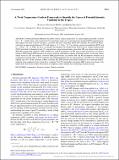A Weak Temperature Gradient Framework to Quantify the Causes of Potential Intensity Variability in the Tropics
Author(s)
Rousseau-Rizzi, Raphaël; Emanuel, Kerry
DownloadPublished version (1.262Mb)
Publisher Policy
Publisher Policy
Article is made available in accordance with the publisher's policy and may be subject to US copyright law. Please refer to the publisher's site for terms of use.
Terms of use
Metadata
Show full item recordAbstract
<jats:title>Abstract</jats:title><jats:p>Potential intensity (PI) has been shown to have a linear sensitivity to sea surface temperature (SST) of about 8 m s<jats:sup>−1</jats:sup> K<jats:sup>−1</jats:sup>, which is close to the sensitivity of PI in simulations subject to a weak temperature gradient (WTG) approximation. This suggests that most of the PI variance is associated with local rather than global SST variations. We verify that PI perturbations are approximately linear in SST, with slopes of 1.8 ± 0.2 m s<jats:sup>−1</jats:sup> K<jats:sup>−1</jats:sup> in radiative–convective equilibrium (RCE) and 9.1 ± 0.9 m s<jats:sup>−1</jats:sup> K<jats:sup>−1</jats:sup> in WTG. To do so, we simulate the sensitivity of both RCE and WTG states in a single-column model (SCM) perturbed by changing in turn CO<jats:sub>2</jats:sub> concentration, aerosol concentrations, prescribed SST, and surface winds speeds. While PI is much more sensitive to SST in WTG than in RCE simulations, the SST itself is much less sensitive to radiative forcing in WTG than in RCE because of the absence of strong atmospheric response. Using these results, we develop a linear model, based on SST and midlevel saturation MSE perturbations, to partition SST and PI perturbations between local components occurring under a WTG constraint and global components that are representative of an RCE state. This model explains up to 95% of the variability of PI in reanalysis. The SCM-derived linear model coefficients are statistically indistinguishable from coefficients from a linear fit of reanalysis PI to SST and midlevel saturation MSE in most ocean basins. Our model shows that North Atlantic PI variations are explained almost entirely by local forcings in recent decades.</jats:p>
Date issued
2021Department
Massachusetts Institute of Technology. Department of Earth, Atmospheric, and Planetary SciencesJournal
Journal of Climate
Publisher
American Meteorological Society
Citation
Rousseau-Rizzi, Raphaël and Emanuel, Kerry. 2021. "A Weak Temperature Gradient Framework to Quantify the Causes of Potential Intensity Variability in the Tropics." Journal of Climate, 34 (21).
Version: Final published version